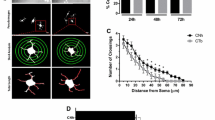Abstract
Neurofibromatosis 2 (NF2) is an inherited disorder characterized by a predisposition to multiple intracranial tumors. The protein encoded by the NF2 gene has striking similarities to ezrin, radixin and moesin (ERM) proteins which link membrane proteins to the cytoskeleton. Therefore, it can be speculated that the disruption of cytoskeletal organization by alterations in the NF2 gene is involved in the development of tumors. It has been reported that the majority of NF2 mutations were nonsense or frameshift mutations that result in premature termination of translation. To facilitate the detection of these mutations, we performed protein truncation test and found that 11 of 14 NF2 patients had truncational mutations (79%). Seven of the 11 patients (64%) had a splicing abnormality which lead to absence of exons in the ERM homology domain. To examine the biological significance of the exon-missing mutations in the ERM homology domain, we expressed the wild-type (wt-NF2) and the various mutant NF2s (mu-NF2s) in a fibroblast cell line by using both liposome-mediated transfection and nuclear microinjection of the expression plasmids. The wt-NF2 showed intense punctate staining in the perinuclear cytoplasm in addition to overall staining of the submembranous area, whereas the mu-NF2s lacking exons in the ERM homology domain showed granular staining at the perinuclear region without any accumulation at the submembrane region. Microinjection of wt-NF2 cDNA into the nucleus of VA13 cells revealed that wt-NF2 protein induced a progressive elongation of cell processes. Furthermore, cells that expressed mu-NF2 had decreased adhesion, which resulted in detachment from the substratum. These findings suggested that the exon-missing mutations in the ERM-homology domain may affect cell membrane–cytoskeleton signaling and consequently disrupt cell–to–cell or cell–to–matrix interaction.
Similar content being viewed by others
Author information
Authors and Affiliations
Rights and permissions
About this article
Cite this article
Koga, H., Araki, N., Takeshima, H. et al. Impairment of cell adhesion by expression of the mutant neurofibromatosis type 2 (NF2) genes which lack exons in the ERM-homology domain. Oncogene 17, 801–810 (1998). https://doi.org/10.1038/sj.onc.1202010
Received:
Revised:
Accepted:
Published:
Issue Date:
DOI: https://doi.org/10.1038/sj.onc.1202010
- Springer Nature Limited
Keywords
This article is cited by
-
Inhibition of the hyaluronan-CD44 interaction by merlin contributes to the tumor-suppressor activity of merlin
Oncogene (2007)
-
The merlin tumor suppressor interacts with Ral guanine nucleotide dissociation stimulator and inhibits its activity
Oncogene (2005)
-
Cellular transformation by a FERM domain mutant of the Nf2 tumor suppressor gene
Oncogene (2002)
-
Mouse Models of Neurofibromatosis 1 and 2
Neoplasia (2002)
-
The TSC1 tumour suppressor hamartin regulates cell adhesion through ERM proteins and the GTPase Rho
Nature Cell Biology (2000)




